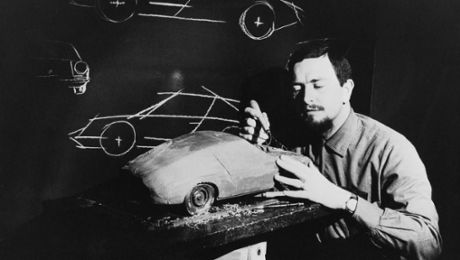For the public, the story of the Porsche 911 Turbo began on 13 September 1973 at the International Motor Show (IAA) in Frankfurt. On that fateful Thursday, a silver 911 stood atop a round presentation podium bedecked in red. Upholstered in blue-black artificial leather, the seat centre panel featured the ‘Black Watch’ tartan pattern in blue-green. The 911 RSR Turbo concept car resembled a 911 Carrera RS 3.0, but for the large lettering on the rear wings of the prototype, which added the critical indication that a new model was in the offing. The word ‘Turbo’ heralded the forthcoming top-of-the-line version of the 911.
Almost a whole year would go by before the first 911 Turbo changed hands as a unique gift. It was none other than Ferry Porsche who gave the sports car, on behalf of all Porsche employees, to his sister Louise Piëch on 29 August 1974 to mark her 70th birthday. It was a very special one-off. On the rear it says ‘Carrera’ instead of ‘Turbo’, which distinguishes this special sports car from the following production vehicles – but the sweeping rear wing indicates that this is a very special model indeed. It is powered by a turbocharged test version of a 2.7-litre engine. Silver on the outside, upholstered with brick-red cowhide leather on the inside, the seat centre panel in a red-blue ‘McLaughlin’ tartan pattern. The car was equipped with the same anniversary package that also featured in the special model marking ‘25 years of driving in its most beautiful form’. This narrow-body 911 Turbo 2.7 Coupé without what would become the typical Turbo widening would remain a one-off. It would go down in the history of the brand as the 911 Turbo ‘No. 1’.
Porsche unveiled the series production version with a 3.0-litre engine on 3 October 1974 at the Paris Motor Show. Painted in Viper Green Diamond, inside it featured black leather and tartan seat centre panels. Although the first Turbo prototype had been shown the year before – at the outset of the oil crisis – customers were by no means deterred. In the spring of 1975, the Turbo was launched globally as the flagship of the 911 series – and it sold better than expected.
One of the fastest of its time
In the advertisement for the market launch in 1974, Porsche described the 911 Turbo as the “crowning glory of a proven concept”. Fast-forward half a century and the words still ring true. Just like the subtitle: “This car combines performance with luxury in perfect harmony. Its superior technology and practical comfort leave nothing to be desired.” The 911 Turbo went down in history as the world’s first series-production sports car with an exhaust-gas-controlled turbocharger. And one of the fastest cars of its time. What set it apart from its competitors was its unrestricted day-to-day usability in combination with its luxurious interior equipment. In the press release from September 1974, Porsche also emphasised the “refined power” and “exclusive sportiness” of the 191 kW (260 PS) sports car.
Initially only planned for a small production run, the model that was internally named 930 would become a Porsche stalwart over the coming five decades. To date, there have been eight generations of the 911 Turbo. Porsche has crowned the company’s model range with the name ‘Turbo’ since 1974. And the ‘Turbo’ recipe for success has not changed in all that time: the constant technical evolution of a timeless classic.

